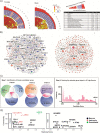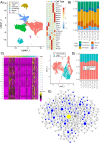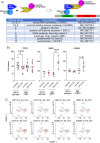Sex specific molecular networks and key drivers of Alzheimer's disease
- PMID: 37340466
- PMCID: PMC10280841
- DOI: 10.1186/s13024-023-00624-5
Sex specific molecular networks and key drivers of Alzheimer's disease
Abstract
Background: Alzheimer's disease (AD) is a progressive and age-associated neurodegenerative disorder that affects women disproportionally. However, the underlying mechanisms are poorly characterized. Moreover, while the interplay between sex and ApoE genotype in AD has been investigated, multi-omics studies to understand this interaction are limited. Therefore, we applied systems biology approaches to investigate sex-specific molecular networks of AD.
Methods: We integrated large-scale human postmortem brain transcriptomic data of AD from two cohorts (MSBB and ROSMAP) via multiscale network analysis and identified key drivers with sexually dimorphic expression patterns and/or different responses to APOE genotypes between sexes. The expression patterns and functional relevance of the top sex-specific network driver of AD were further investigated using postmortem human brain samples and gene perturbation experiments in AD mouse models.
Results: Gene expression changes in AD versus control were identified for each sex. Gene co-expression networks were constructed for each sex to identify AD-associated co-expressed gene modules shared by males and females or specific to each sex. Key network regulators were further identified as potential drivers of sex differences in AD development. LRP10 was identified as a top driver of the sex differences in AD pathogenesis and manifestation. Changes of LRP10 expression at the mRNA and protein levels were further validated in human AD brain samples. Gene perturbation experiments in EFAD mouse models demonstrated that LRP10 differentially affected cognitive function and AD pathology in sex- and APOE genotype-specific manners. A comprehensive mapping of brain cells in LRP10 over-expressed (OE) female E4FAD mice suggested neurons and microglia as the most affected cell populations. The female-specific targets of LRP10 identified from the single cell RNA-sequencing (scRNA-seq) data of the LRP10 OE E4FAD mouse brains were significantly enriched in the LRP10-centered subnetworks in female AD subjects, validating LRP10 as a key network regulator of AD in females. Eight LRP10 binding partners were identified by the yeast two-hybrid system screening, and LRP10 over-expression reduced the association of LRP10 with one binding partner CD34.
Conclusions: These findings provide insights into key mechanisms mediating sex differences in AD pathogenesis and will facilitate the development of sex- and APOE genotype-specific therapies for AD.
Keywords: APOE genotype; Alzheimer’s disease; Gene co-expression network; Key driver genes; LDL receptor related protein 10 (LRP10); Sex difference.
© 2023. The Author(s).
Conflict of interest statement
All authors declared no conflict of interest.
Figures






References
Publication types
MeSH terms
Substances
Grants and funding
- R01 AG072562/AG/NIA NIH HHS/United States
- I01 BX003380/BX/BLRD VA/United States
- R56 AG058655/AG/NIA NIH HHS/United States
- I01 BX005934/BX/BLRD VA/United States
- R01 AG068030/AG/NIA NIH HHS/United States
- RF1 AG074010/AG/NIA NIH HHS/United States
- RF1 AG048923/AG/NIA NIH HHS/United States
- RF1 AG057440/AG/NIA NIH HHS/United States
- R01 AG057907/AG/NIA NIH HHS/United States
- U01 AG046170/AG/NIA NIH HHS/United States
- U01 AG052411/AG/NIA NIH HHS/United States
- RF1 AG054014/AG/NIA NIH HHS/United States
- R01 AG048923/AG/NIA NIH HHS/United States
LinkOut - more resources
Full Text Sources
Medical
Miscellaneous

